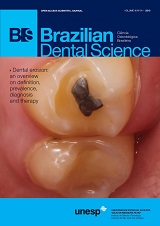A comparison of methods used to determine chewing side preference in deciduous, mixed and permanent dentitions
DOI:
https://doi.org/10.14295/bds.2013.v16i1.870Abstract
Objective: The purpose of this study was to determine whether ‘chewing side preference’ (CSP) is correlated to ‘chewing side preference during the first chewing cycle’ (CSP1ºC) in the deciduous, mixed and permanent dentitions.Methods: Three-hundred subjects were divided in 3 groups: Group 1 – 100 children 3-5 years old, primary dentition; Group 2 – 100 children 6-12 years old, mixed dentition; Group 3 – 100 subjects 18-47 years old, permanent dentition. CSP was determined using a method developed by McDonnell et al. (2004). Subjects were given a piece of gum and the position of the chewing gum was recorded 7 times as right or left. Subjects were classified as ‘observed preferred chewing side’ (OPCS) when they performed 5/7, 6/7 or 7/7 strokes on the same side. OPCS corresponded to the CSP. CSP1ºC was determined using a method developed by Hoogmartens and Caubergh (1987). Subjects were given five pieces of gum and the position of the chewing gum at first chewing cycle was recorded as right or left. For each subject, an index (I) was performed. The Chi-square (X2) and phi correlation (r) tests were used to investigate signi?cant correlations between CSP and CSP1ºC. Results: There was a strong positive and significant correlation between CSP and CSP1ºC for primary dentition (p=0.000; r=0.82), for mixed dentition (p=0.000; r=0.81) and a very strong positive and significant correlation for permanent dentition (p=0.000; r=0.90). Conclusion: CSP can be significantly correlated to CSP1ºC for primary dentition, mixed dentition and permanent dentition, and these are strong positive relationships for primary and mixed dentitions and very strong positive relationship for permanent dentition.
Downloads
Downloads
Published
How to Cite
Issue
Section
License
Brazilian Dental Science uses the Creative Commons (CC-BY 4.0) license, thus preserving the integrity of articles in an open access environment. The journal allows the author to retain publishing rights without restrictions.
=================




























